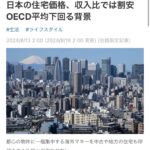(The English version will follow the Japanese version.)
3月の下旬に国土交通省が令和6年1月1日時点の公示地価を発表しました。喜ばしいことに、32年ぶりに下落が止まりました。
日本のデフレの終わりを象徴するようなニュースですね。富山県がまとめた公示価格についてはこちら

さえない富山県の地価
この地価は、平均値ですから、上がるところもあれば下がるところもあります。
富山市と舟橋村のみ上昇
上昇したのは富山市と舟橋村のみで、それ以外の市町村は引き続き下落しています。
よって、調査地点の数から見れば、富山県の地価上昇は富山市に限られた状況と言えると思います。
富山市の中でも、地価の上昇率が最も大きいのは「桜町」となっています。 桜木町やそれ以外の上昇率が高い場所は、いずれも富山駅前となっています。
呉西は中心部でも下落
下落率ワーストワンは、高岡市福田六家(高岡インターチェンジ近く国道8号線のマクドナルドの山側)、次いで南砺市本町4丁目(商店街)です。 第三位は南砺市是安(城端駅に近い商店街だそうです)。
地価そのものはもっと安いところはあります。これらは比較的市街地にあり、それらが下がっているので深刻です。
資産としての不動産
土地を資産と考えて保有されている方も多いと思います。さて、その土地は本当に資産でしょうか?それとも負債でしょうか?
例えば高岡市の場合、市全体で見れば毎年1%程度地価は下落しています。加えて、不動産では固定資産税を考えなければいけません。毎年持っているだけで取られていくのです。都市部の場合は、都市計画税も取れます。両方合わせると、市町村により多少の違いはありますが、1.7%かかります。
もちろんこの土地の下落が一過性であれば良いですが、人口減少の中でその一過性かどうかが問題です。
例えば2012年、アベノミクスが始まった年を基準に考えてみましょう。
同じ資産という観点で株価を考えると、日経平均は221%(2.21倍)上昇しています。
安定資産と言われる金は約24%上昇です。 (株や金等の資産に対しては、保有しているだけで税金はかかりません。)
それに対して高岡の地価は、7.7%下落しています。
もちろん土地を、自分の自宅として持っていれば、地価を気にする必要はないかもしれません。
しかし、誰も住んでいない宅地や、草刈りや除草剤を撒いているだけの田んぼを、値上がりを期待して持っているのは考えものです。
もちろん、これらの意思決定は個人の責任となりますので、よく検討する必要があります。ですが、一度じっくりと考えてみてはいかがでしょうか?(言いっ放しではありません。ファイナンシャルプランナーでもありますので相談にのります!)
関連記事:富山県内の不動産市況調査レポート Real Estate Market Conditions in Toyama
In late March, the Ministry of Land, Infrastructure, Transport and Tourism announced the official land prices as of January 1st of Reiwa 6 (2024).
It’s heartening that, after 32 years, the decline has stopped. This news symbolizes the end of deflation in Japan.
However, these land prices are averages, so there are areas where prices have risen as well as areas where they have fallen.
The areas that saw an increase were Toyama City and Funahashi Village. Looking at it from a municipal level, only Toyama City and Funahashi Village saw increases, while other cities and towns continued to experience declines.
Therefore, based on the number of surveyed locations, it can be said that the rise in land prices in Toyama Prefecture is mainly due to Toyama City.
Among the areas in Toyama City, “Sakuramachi” has seen the largest increase in land prices. These areas are all located near train stations.
The worst decline was in Takayama City’s Fukuda Roku-ke area (near Takayama Interchange on the mountain side of National Route 8, near McDonald’s), while the least desirable was Minami-Tonami City’s Honmachi 4-chome (shopping district) and the third is Nanto City’s Koreyasu (a shopping district near Joto Station).
There are even cheaper areas in terms of land prices. These are relatively in urban areas, and their decline is concerning.
Real estate as an asset?
Now, many people may consider their land as an asset.
However, is that land really an asset or a liability?
For example, in Takayama City, land prices have been declining by about 1% per year overall. Also, one must consider property taxes every year just for owning the land.
Of course, if the decline in land value is temporary, that’s fine. But it becomes a problem in the context of population decline.
Let’s consider the year 2012 when Abenomics began.
Since then, land in Takayama has decreased by 7.7%. In comparison, the Nikkei Average has increased by 221%, and stable assets like gold have increased by 24%.
Just owning these assets does not incur taxes.
Of course, if you own land as your primary residence, you may not need to worry about land prices.
However, owning vacant land or farmland where you only apply weed killers is something to think about in terms of expecting appreciation.
Of course, the final decision rests with individual responsibility.




